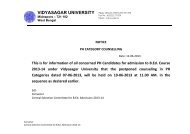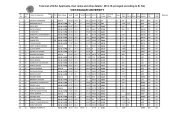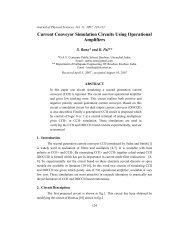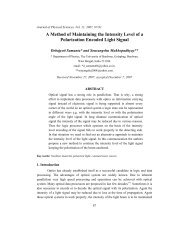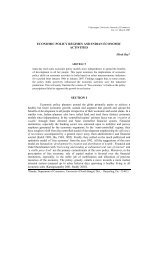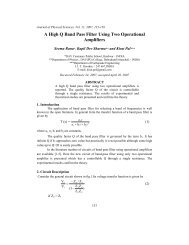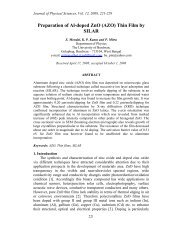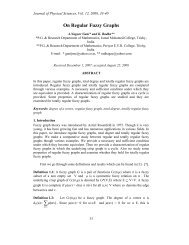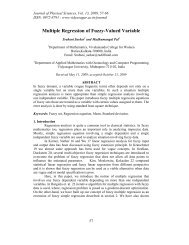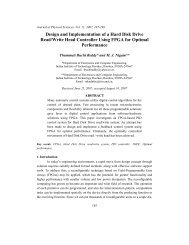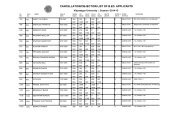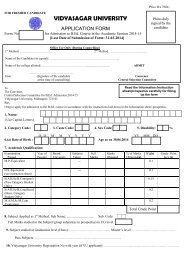VIDYASAGAR UNIVERSITY JOURNAL OF COMMERCE
VIDYASAGAR UNIVERSITY JOURNAL OF COMMERCE
VIDYASAGAR UNIVERSITY JOURNAL OF COMMERCE
You also want an ePaper? Increase the reach of your titles
YUMPU automatically turns print PDFs into web optimized ePapers that Google loves.
CORPORATE RESTRUCTURING THROUGH MERGERS AND ACQUISITIONS: A CASE STUDY<br />
operational efficiency etc. (3) Achieving synergistic benefits, (4) Obtaining several forms of<br />
tax benefits available under the Income Tax Act 1961 with the help of proper tax planning,<br />
(5) Diversifying the business risk with the help of merger between unrelated firms and<br />
thereby reducing or eliminating the fluctuation of income due to seasonal or economic cycles<br />
and consequently stabilizing the income flow, (6) Reducing competition in the market and<br />
capturing the most significant part of the market and above all (7)Enhancing the value of the<br />
firm and ensuring the long run survival, existence and growth of the enterprise in this everchanging,<br />
competitive and dynamic business world.<br />
In India, the fever of mergers and acquisitions took place after the declaration of the New<br />
Economic policy in 1991 where Indian economy was made free from unnecessary<br />
bureaucratic control of the Government. Private sector participation was allowed to welcome<br />
the tide of industrialization by following the strategy of LPG in order to integrate the Indian<br />
economy with the world economy. In such a changing scenario, several banking institutions<br />
started restructuring themselves by resorting to the strategy of mergers and acquisitions. For<br />
instance, there have been 34 merger deals in Indian banking industry from 1969 (i.e., the<br />
year of starting the bank nationalization) to 2004. [See Annexure for details].<br />
In this backdrop, the present study has been conducted with reference to ICICI Bank Ltd.,<br />
which was merged with the Bank of Madura on 10 th March 2001. This study basically aims<br />
at evaluating the performance of this bank before and after the merger with the help of some<br />
ratios and also by utilizing the technique of profitability measurement under the traditional<br />
and modern concept. There are many systems of traditional performance measurement, such<br />
as Net Profit Margin, Operating Profit Margin, Earning Per Share, Return on Investment<br />
(ROI) etc.. In this study, ROI and EPS have been used for measuring performance under the<br />
traditional system. However, ROI is the best among all the traditional performance<br />
measurement vehicles since it considers the four major dimensions of performance<br />
measurement viz, Profitability, Liquidity, Capital Structure and Turnover position. Under the<br />
modern approach, performance has been measured with the help of Economic Value Added<br />
(EVA) which is a modern technique and is claimed to be a much more clear indicator of<br />
corporate surplus. EVA is generally defined as any profit earned over and above the cost of<br />
capital. Some ratios used here for measuring performance are Return on Assets (ROA),<br />
Return on Net Worth (RONW), Net Profit to Total Funds, Interest Income / Total Funds etc.<br />
This article has been designed into eight sections. Section II provides a brief picture of the<br />
company’s profile. Section III highlights the objectives of the study. The review of relevant<br />
literatures has been shown in Section IV. Section V deals with the Database and<br />
Methodology used in this study. Section VI has been devoted to the making of SWOT<br />
analysis of the banks. Major computations and findings have been shown in Section VII and<br />
finally Section VIII spells out the overall conclusion of the study.<br />
Company Profile<br />
ICICI Bank is a commercial bank promoted by ICICI Ltd., an Indian Financial Institution. It<br />
is the second largest bank in India, having 562 branches and extension counters across India<br />
and 1910 ATMs.<br />
80 Vidyasagar University Journal of Commerce



